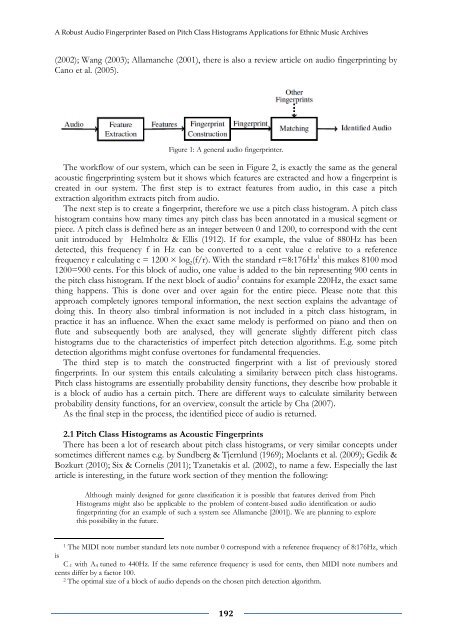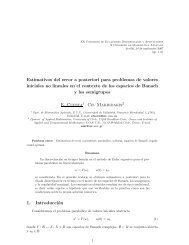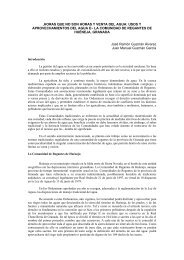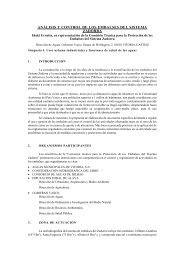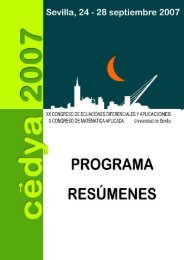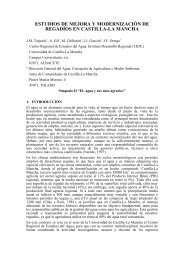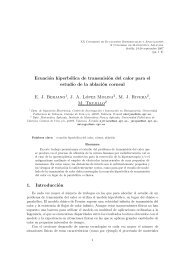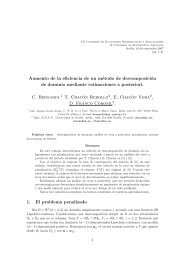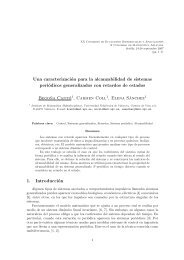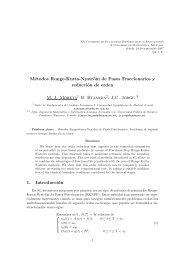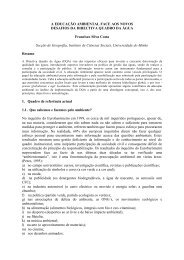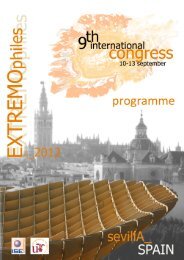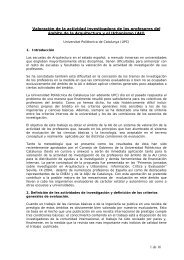LIBRO DE ACTAS (pdf) - Universidad de Sevilla
LIBRO DE ACTAS (pdf) - Universidad de Sevilla
LIBRO DE ACTAS (pdf) - Universidad de Sevilla
Create successful ePaper yourself
Turn your PDF publications into a flip-book with our unique Google optimized e-Paper software.
A Robust Audio Fingerprinter Based on Pitch Class Histograms Applications for Ethnic Music Archives<br />
(2002); Wang (2003); Allamanche (2001), there is also a review article on audio fingerprinting by<br />
Cano et al. (2005).<br />
Figure 1: A general audio fingerprinter.<br />
The workflow of our system, which can be seen in Figure 2, is exactly the same as the general<br />
acoustic fingerprinting system but it shows which features are extracted and how a fingerprint is<br />
created in our system. The first step is to extract features from audio, in this case a pitch<br />
extraction algorithm extracts pitch from audio.<br />
The next step is to create a fingerprint, therefore we use a pitch class histogram. A pitch class<br />
histogram contains how many times any pitch class has been annotated in a musical segment or<br />
piece. A pitch class is <strong>de</strong>fined here as an integer between 0 and 1200, to correspond with the cent<br />
unit introduced by Helmholtz & Ellis (1912). If for example, the value of 880Hz has been<br />
<strong>de</strong>tected, this frequency f in Hz can be converted to a cent value c relative to a reference<br />
frequency r calculating c = 1200 × log 2(f/r). With the standard r=8:176Hz 1 this makes 8100 mod<br />
1200=900 cents. For this block of audio, one value is ad<strong>de</strong>d to the bin representing 900 cents in<br />
the pitch class histogram. If the next block of audio 2 contains for example 220Hz, the exact same<br />
thing happens. This is done over and over again for the entire piece. Please note that this<br />
approach completely ignores temporal information, the next section explains the advantage of<br />
doing this. In theory also timbral information is not inclu<strong>de</strong>d in a pitch class histogram, in<br />
practice it has an influence. When the exact same melody is performed on piano and then on<br />
flute and subsequently both are analysed, they will generate slightly different pitch class<br />
histograms due to the characteristics of imperfect pitch <strong>de</strong>tection algorithms. E.g. some pitch<br />
<strong>de</strong>tection algorithms might confuse overtones for fundamental frequencies.<br />
The third step is to match the constructed fingerprint with a list of previously stored<br />
fingerprints. In our system this entails calculating a similarity between pitch class histograms.<br />
Pitch class histograms are essentially probability <strong>de</strong>nsity functions, they <strong>de</strong>scribe how probable it<br />
is a block of audio has a certain pitch. There are different ways to calculate similarity between<br />
probability <strong>de</strong>nsity functions, for an overview, consult the article by Cha (2007).<br />
As the final step in the process, the i<strong>de</strong>ntified piece of audio is returned.<br />
2.1 Pitch Class Histograms as Acoustic Fingerprints<br />
There has been a lot of research about pitch class histograms, or very similar concepts un<strong>de</strong>r<br />
sometimes different names e.g. by Sundberg & Tjernlund (1969); Moelants et al. (2009); Gedik &<br />
Bozkurt (2010); Six & Cornelis (2011); Tzanetakis et al. (2002), to name a few. Especially the last<br />
article is interesting, in the future work section of they mention the following:<br />
is<br />
Although mainly <strong>de</strong>signed for genre classification it is possible that features <strong>de</strong>rived from Pitch<br />
Histograms might also be applicable to the problem of content-based audio i<strong>de</strong>ntification or audio<br />
fingerprinting (for an example of such a system see Allamanche [2001]). We are planning to explore<br />
this possibility in the future.<br />
1 The MIDI note number standard lets note number 0 correspond with a reference frequency of 8:176Hz, which<br />
C-1 with A4 tuned to 440Hz. If the same reference frequency is used for cents, then MIDI note numbers and<br />
cents differ by a factor 100.<br />
2 The optimal size of a block of audio <strong>de</strong>pends on the chosen pitch <strong>de</strong>tection algorithm.<br />
192


